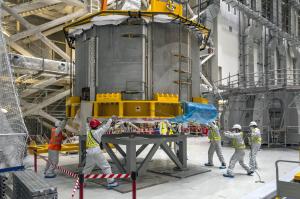The "table" is set for the first module
Like the 18 toroidal field coils that surround the vacuum vessel, the central solenoid's superconducting windings, and the protruding "lead" that feeds the high-voltage, are made of niobium-tin, a compound that, contrary to the niobium-titanium of the poloidal field coils, is quite brittle. This relative fragility explains the extreme care that went into the lift operation's preparation and execution.
Lifting, stacking and assembling the six modules into a 18-metre high, 1,000-tonne magnet will require a set of high-precision tools also procured by US ITER and already delivered. The total value of the assembly tooling contracts is in excess of USD 10 million.
Once finalized, the ITER central solenoid will be placed at the very centre of the Tokamak pit where the central column (a temporary assembly tool) presently stands.



